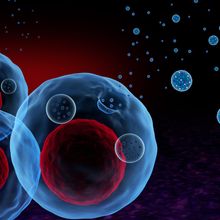Login
Subscribeimmunotherapy

Next-generation CAR and TCR Cancer Therapies
Danielle Gerhard, PhD | Mar 15, 2024 | 10+ min read
From smart receptors to novel biologics, scientists plan to overcome the challenges
of treating solid tumors.

Turning up the Heat on Brain Tumors
Aparna Nathan, PhD | Jul 17, 2023 | 3 min read
Oncolytic viruses can help glioblastoma respond to immunotherapy.

Tapping into Immunotherapy’s Potential to Help More People
The Scientist Staff | 2 min read
Discover what researchers have learned about varying immunotherapy response rates between patients with the same cancer types.

Chek-Mate for Gliomas
Aparna Nathan, PhD | May 22, 2023 | 3 min read
New research may make immunotherapy possible for hard-to-treat brain tumors.

Opinion: New Diabetes Drug Signals Shift to Preventing Autoimmunity
Jane Buckner, MD and Carla Greenbaum, MD | Mar 1, 2023 | 4 min read
A therapy for type 1 diabetes is the first to treat patients before symptoms appear, paving the way toward preventing this and other autoimmune diseases.

Hijacking Viruses: Optimizing Lentivirus-Based Cell Engineering
The Scientist | 1 min read
Filippo Rossignoli discusses the challenges he faced when employing lentiviruses to produce immunotherapies and how he overcame these obstacles.

Q&A: What if Immune Cells Don’t Actually Detect Viruses and Bacteria?
Dan Robitzski | Feb 3, 2023 | 10+ min read
The Scientist spoke with Jonathan Kagan about his idea that immune cells respond to “errors” made by unsuccessful pathogens, not the pathogens themselves.

Hypertranscription by Tumors Is Linked to Poorer Cancer Outcomes: Study
Sophie Fessl, PhD | Dec 13, 2022 | 3 min read
The extent to which transcription is higher in tumor cells than in surrounding nontumor cells is associated with bad prognoses in several cancer types.

New Strategies for Cancer Immunotherapy
The Scientist | 2 min read
An expert panel will discuss the interplay between cancer and the immune system, and how researchers develop immunotherapies and other immune-supporting strategies against cancer.

Immunotherapy Treats Fibrosis in Mice
Alejandra Manjarrez, PhD | Sep 15, 2022 | 4 min read
Researchers report that vaccination against proteins found on profibrotic cells reduced liver and lung fibrosis in laboratory rodents.

Nanoparticles Spur Mouse Immune System to Attack Cancer
Shafaq Zia | Sep 13, 2022 | 2 min read
A study finds that engineered exosomes are effective in mice, but their potential use in humans raises safety questions.

The Scientist’s Journal Club: Cancer
The Scientist | 1 min read
Scientists present the latest research on immune cell responses to cancer, the role of epigenetics in cancer, and molecular imaging of the tumor microenvironment.

A Brave New World for Spatial Genomics in Cancer Research
Nele Haelterman, PhD | Jun 27, 2022 | 3 min read
A new CRISPR screening technology allows scientists to recreate tumor heterogeneity in vivo and study how it affects all aspects of cancer biology.

Cancer Cells Go Incognito to Cause Therapy Relapse
Niki Spahich, PhD | Jun 27, 2022 | 3 min read
Dormant cancer cells and dysfunctional immune cells living together in a tumor niche form a therapy-resistant reservoir.

The Basics of the Tumor Microenvironment
Johanna Pruller, PhD | 4 min read
Learn about the tumor microenvironment (TME), a key influencer of cancer growth, spread, and treatment success.

Salmonella Injection Helps the Mouse Immune System Kill Tumors
Dan Robitzski | May 16, 2022 | 3 min read
Nanoparticle-coated bacteria can capture tumor antigens and deliver them to immune cells, triggering a response that improved survival rates in mice.

Infographic: Salmonella Shuttle Tumor Antigens to Immune Cells
Dan Robitzski | May 16, 2022 | 1 min read
Nanoparticle-coated bacteria carry cancer-derived proteins to dendritic cells, enabling the immune system to launch a response in a mouse model.

A Guide to Mapping the Complexity of the Tumor Microenvironment
The Scientist | 1 min read
High-quality sample preparation, single-cell analysis, and ultra-high content spatial proteomics for multi-dimensional research workflows.

Traversing Narrow Channels Helps Metastatic Cancer Cells Survive
Dan Robitzski | Apr 14, 2022 | 4 min read
In vitro and mouse experiments show how cancer cells forced through tiny pores—mimicking the physical experience of metastasis—resisted programmed cell death and avoided detection by the immune cells that would normally kill them.
